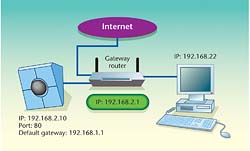For security installation companies to connect their devices onto these networks, they need to know the common concepts and terms used to network computers and other devices. To determine your level of knowledge of network technology, take SDM’s “20 Questions†quiz. Scroll down to score yourself.
1. Data communications
standards are produced by:
a. SIA
b. FCC
c. IEEE
d. IBM
2. A computer network within
a building is called a:
a. WAN
b. MAN
c. LAN
d. PAN
3. Typical Ethernet networks
transmit data at:
a. 200 miles per hour.
b. the speed of sound.
c. 50-60 Mbps (Megabits
per second).
d. 100 Mbps.
4. Each Wi-Fi installation
requires a specific site license
from the Federal Communica-
tions Commission.
a. True
b. False
5. Computer protocols, such
as Ethernet and Wi-Fi,
transmit data in:
a. envelopes.
b. containers.
c. packets.
d. an uninterrupted stream.
6. To connect a node to an Ethernet
network, the device must have a:
a. telephone line.
b. DSL modem.
c. T1 line.
d. NIC .
7. A typical IP address for a LAN
device cannot be:
a. 45.234.1.46
b. 192.168.1.50
c. 192.166.2.34
d. 192.168.0.456
8. Networks use _____ to provide
temporary IP addresses to
connected nodes.
a. TCP/IP
b. DHCP
c. ARP
d. UDP
9. UTP Ethernet networks will
usually use the 568-B pinout
for jacks and plugs.
a. True
b. False
10. In addressing, what number
stays constant even when a
node’s IP address has been
changed?
a. DHCP
b. Default router
c. MAC
d. Switch port setting
11. Why do routers have two
IP addresses?
a. One for the WAN,
one for the LAN
b. One for transmitting,
one for receiving
c. One for routing,
one for switching
d. One for data, one for
packet overhead
12. How can a Wi-Fi network
be made more secure?
a. Limit users by MAC address.
b. Disable broadcast
of SSID name.
c. Enable WEP encryption.
d. All of the above
13. Network cabling standards
for installations within a
building are included in:
a. FCC regulations
b. EIA/TIA 568
c. IEEE 802.11g
d. NSCA regulations
14. In a structured cabling
installation, cabling between
the main cross-connect and
an intermediate cross-
connect is called:
a. the pipeline.
b. 100 Megabit Ethernet.
c. data conduit.
d. the backbone.
15. 10/100 Ethernet transmissions
use how many pairs to
transmit and receive data?
a. One
b. Two
c. Three
d. Four
16. Which medium can carry
communications signals
furthest?
a. Cat 3 UTP
b. Cat 6 UTP
c. Fiber optics
d. Coaxial cable
17. You are at the job site, and
you need to know the client’s
Internet IP address. You would:
a. call the ISP.
b. go on the Internet to
www.whatismyip.com.
c. ask the customer for
their ISP contract.
d. get the IP from their
desktop computer.
18. To keep the IP address of a
cable modem or xDSL adapter
from changing, you can:
a. connect the power
transformer to a UPS.
b. place the device into a
secured cabinet.
c. order static IP addresses
from the ISP.
d. disable the adapter’s firewall.
19. UTP stands for:
a. unlimited transmission protocol.
b. unshielded twisted pair.
c. universal transmitter potential.
20. Firewall settings can block
the transmission of IP
network cameras.
a. True
b. False

Wally ‘Larman’s Pinging Problem
The security industry’s bungling installer, Wally ‘Larman, programmed and installed a network camera onto a client’snetwork, as shown here. Wally can “ping†the camera and can view the camera’s images from the local computer, but cannot access the camera over the Internet. He’s confident, as always, that he has opened the router’s firewall for access to software port 80. Wally thinks the camera is defective. Can
you spot Wally’s problem and determine how to fix it?
Answer below
20 ANSWERS About Networking
Score yourself on your knowledge of networking technology.1. c – The Institute of Electronic and Electrical Engineers (IEEE) is the standards-setting body for network communications.
2. c
3. d – While older Ethernet networks may operate at 10 Mbps (Megabits per second), most current network devices can communicate at either 10 or 100 Mbps. (Typical throughout, however, is actually 50 to 60 Mbps.)
4. False – 802.11b or .g Wi-Fi devices operate at 2.4 GHz, which is designated by the FCC as an open frequency range; any device can use it.
5. c
6. d – The Network Interface Card (NIC) provides Ethernet communications for a computer or other network device.
7. d – Internet and LAN IP addresses have four number groups, called octets, separated by periods. No individual number group can be of a higher value than 255.
8. b – Dynamic Host Control Protocol (DHCP) provides temporary and automatic IP addressing for network devices.
9. a – True
10. c – The MAC (Media Access Control) address is a unique number coded into Ethernet devices at the factory. The MAC is also called the physical or Ethernet address.
11. a
12. d – Most Wi-Fi access points and routers are factory defaulted to allow “open†access. All security measures should be programmed when installing Wi-Fi equipment.
13. b – The Electronic Industry Association and the Telecommunications Industry Association set the standards for network cabling in the United States.
14. d
15. b – While 10/100 uses two pairs, Gigabit Ethernet uses all four pairs of a typical UTP cable for communications.
16. c
17. b
18. c
19. b
a – True
Number of correct answers rating
20 Excellent
18-19 Very good
16-17 Good
14-15 Average
12-13 Below average
11 or fewer Poor
